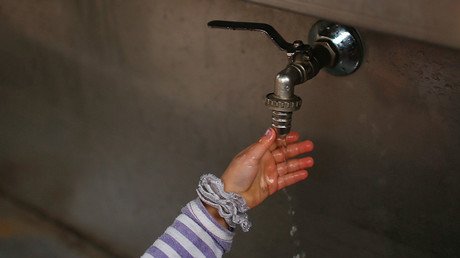US meat producers to blame for ‘toxic’ Gulf ‘Dead Zones,’ destroyed prairies – report

A new major report by a prominent environmental group has accused US industrialized meat producers, particularly market leader Tyson, of devastating the American landscape and “normalizing a no-questions-asked approach to the environment.”
“Demand for feed crops is driving widespread water contamination across the country, destroying America’s last native prairies, and releasing potent greenhouse gases,” says a 16-page report, titled Mystery Meat II, produced by Mighty, a conservation campaign group established by former Congressman Henry Waxman last year.
Did you know who’s responsible for the #DeadZone in the Gulf? Tell @TysonFoods to clean its act. #CleanItUpTysonhttps://t.co/iXk0gM41WRpic.twitter.com/r6bnJpfbiq
— Mighty (@StandMighty) August 1, 2017
“When excess fertilizer and manure wash off fields that grow feed, they contaminate local drinking water and create toxic algae blooms that cause vast Dead Zones that are toxic to aquatic life in the Gulf of Mexico, Chesapeake Bay, and Great Lakes.”
The Gulf of Mexico dead zone causes a ripple effect for fisherman, scientists, and animals. https://t.co/OfV8IzhezRpic.twitter.com/lTrjGLq4pi
— Restore the Delta (@RestoreDelta) July 21, 2017
This summer, the National Oceanic and Atmospheric Administration (NOAA) expects to see a record-breaking Dead Zone – an area abandoned by marine wildlife as a result of a lack of oxygen and pollution – of about 8,000 square miles, the size of the state of New Jersey, where the Mississippi River flows into the Gulf of Mexico.
The US farms more beef and poultry than any other country, and the third-most pork, while an average citizen consumes over 200lbs of meat a year.
Mighty has decided to target Tyson, which produces about 20 percent of all meat in the US, and whose fields and facilities are concentrated in the most polluted areas, according to the report.
“The company’s market dominance means that it has standardized many of the practices and market incentives contaminating our water and destroying our landscape today. But it also means that Tyson has the ability to lead the transformation of America’s agriculture industry to end these harmful practices,” say the authors.
Mighty has called upon the company, and others in its wake, to use only “pollution-free feed” from farms where there is no significant fertilizer runoff, to use more than just corn and soy to rear its livestock, and to impose a moratorium on new farms in untouched habitats such as prairies.
“Americans should not have to choose between producing food and having healthy clean water,” Mighty Earth campaign director Lucia von Reusner said, adding that agribusinesses “have a responsibility to their customers and the public to clean up.”
Sustainability is an investment in our communities.
— Tyson Foods (@TysonFoods) May 30, 2017
It's where we work, play, and live!
We're thankful for the mission of @nature_orgpic.twitter.com/lqzfMHyhIL
Tyson, which has recently made an effort of playing up its sustainability credentials, has rankled at being singled out.
“We don’t agree with the group’s characterization of our company but share its interest in protecting the environment,” the Arkansas-based company said in a statement, published by the Guardian. “It’s true the livestock and poultry industry is a major buyer of grain for feed, however, the report fails to note that a large percentage of corn raised in the US is used for biofuel and that a significant portion is used for human consumption.”
Cargill, another major producer name-checked in the report, told the Guardian that industry practices are improving.
“We continue to improve livestock feed efficiency. Over the last 15 years we have seen an overall trend in reducing the volume of feed for each pound of beef produced,” said the Minnesota-headquartered corporation.













